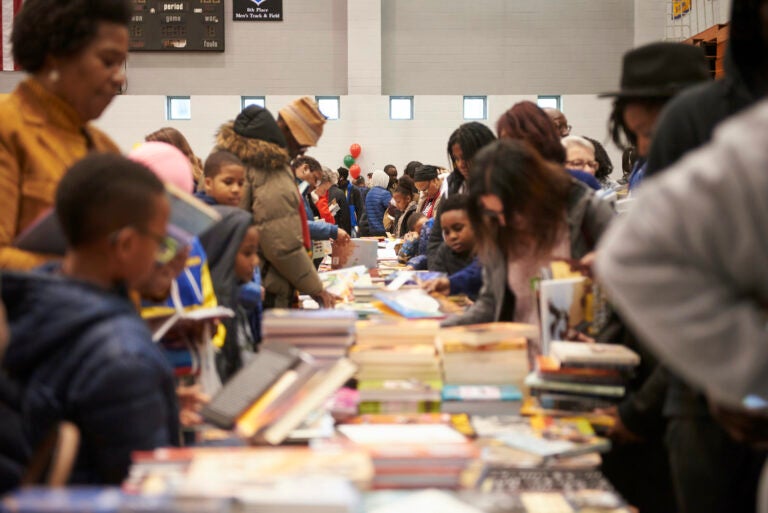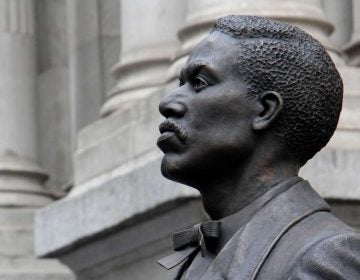After 30 years, African American Children’s Book Fair expands to the Convention Center
After 30 years, the African American Children’s Book Fair has expanded into the Pennsylvania Convention Center.

File photo: The 28th annual African American Children's Book Fair at the Community College of Philadelphia was held pre-pandemic on Feb. 1, 2020. The fair is organized by Vanesse Lloyd-Sgambati, who is organizing the inaugural "Juneteenth - Celebrating Literary and Artistic Freedom," on Saturday. (Natalie Piserchio for WHYY)
The African American Children’s Book Fair is boldly charging into its 30th anniversary this weekend, in its largest venue ever: the Pennsylvania Convention Center.
One of the largest and longest-running literary events for children’s books centering on African Americans started in 1992 in the Wanamaker’s department store (now Macy’s). That was so long ago, it was still called Wanamaker’s.
Later, founder Vanesse Lloyd-Sgambati partnered with the Community College of Philadelphia, where for many years the largest public event that gathers Black authors together would attract about 4,000 people in a single day.
“I kept saying to myself: ‘I really need a bigger space,’” she said. “But the Pennsylvania Convention Center was out of our reach.”
The fair could not be held in-person last year due to the pandemic, so Lloyd-Sgambati took it online. This year she said the Community College was not available, and she did not want to “go back into my corner and go virtual.”
It was time to go big, and step up to the Convention Center.
“It did feel right,” said Lloyd-Sgambati. “It is time to start living. It’s time to start engaging. We have to take baby steps.”
The fair will be taking COVID precautions, insisting all visitors and participants wear surgical masks. More than 30 authors will be there in-person to do talks, meet with children and parents, and sign books.
One of them, Karyn Parsons, said it’s the highlight of the job.
“I love it. My favorite thing to do is to go and visit the kids and talk to them and hear their questions and their observations,” she said.
Parsons recently started to resume in-person school visits.
“It’s different. You go to space and you can’t see their faces behind the masks. You’re wondering: ‘Are they listening to everything?’” she said. “You wonder until you get to the Q&A section. It’s like: ‘Oh, good, they were. They were with me.’”
Parsons achieved fame early in life playing opposite Will Smith in the original “Fresh Prince of Bel-Air” TV show, as Hilary Banks. Since then she has turned to producing stories for children.
Through her company Sweet Blackberry, Parsons has created a series of animated short films to share with schools and libraries, telling the stories of lesser-known historical Black figures: like Bessie Coleman, the first Back woman to become a licensed pilot in 1921 (predating Amelia Earhart by 2 years), and Henry “Box” Brown, an enslaved man in Virginia who crated himself up in 1849 and successfully shipped himself to freedom in Philadelphia. Brown later became a touring magician.
“My mother was a librarian. She came across his story, and called me and told me about it,” said Parsons about Henry “Box” Brown. “I thought it was insane. But I also thought it was really crazy I hadn’t heard it and my friends hadn’t heard the story. That was the story that just made me really want to get these incredible, inspiring stories out to kids.”
So far, two of her animated films have been published as picture books. At the book fair Parsons will be presenting the more recent “Saving the Day: Garrett Morgan’s Life-Changing Invention of the Traffic Signal.” It tells the story of the Black, self-taught inventor in turn-of-the-century Ohio who created the three-position stoplight, as well as an early version of the gas mask.
Other featured authors at the fair include Natasha Tarpley, who wrote “I Love My Hair!” (2001) now considered a classic. She will present her new book, “The Me I Choose To Be.” Also present will be bestselling author Jason Reynolds, who is the Library of Congress’ official Ambassador for Young People’s Literature.
Author Leah Henderson (“Daddy Speaks Love”) is a longtime participant in the fair. She calls it “magical.”
“Not only do young people get to see themselves reflected in the books showcased at the book fair, they have the opportunity to meet the Black creatives behind the work,” she wrote in an email. “Each connection is a seed of possibility for the young people who come out.”
Philadelphia author and illustrator Eric Battle will be at the fair to present “BLAM! Black Lives Always Mattered!,” a graphic novel telling the stories of 14 historic Black people from Philadelphia. Battle is the creative director of the project created by the Charles L. Blockson Afro-American Collection at Temple University.
Battle reached out to 12 illustrators, assigning to each a life story, like singer Marian Anderson (by Nancy Devard), architect Julian Abele (by Mike Leeke), and the physician Walter P. Lomax (by Dwayne Turner).
By using so many artists, Battle was able to give each life story its own visual style. He wanted the book to be more educational than a typical graphic novel, and more fun than a typical history textbook.
That style is designed “to make the stories as relatable and accessible to folks who may not be familiar with comic books and graphic novels,” he said. “We don’t want the information to come across as being dry.”
The book, funded by a grant from the Pew Center for Arts and Heritage, had a small print run of just a few thousand copies intended exclusively for school and libraries in the Philadelphia region. By special permission the Book Fair will have a limited number of copies for sale.
This will be Battle’s first time participating in the book fair, but not his first time attending. He has been there many times in past years as a patron.
“I love books. I love beautiful books. I love illustrated books,” he said. “It’s a chance for me to connect with illustrator friends and author friends. The event just has great energy. It’s almost like a comic book convention, but not as frantic, you know?”
However, there may be a Comic-Con energy at the Convention Center this year, as the children’s book fair will be sharing the building with the Philadelphia Tattoo Arts Festival.
The mission of Children’s Book Fair is to showcase Black-centered children’s books, both new and classic, and to encourage parents to develop small libraries in their own homes. That mission became more urgent during the pandemic which forced many children into seemingly endless hours of screen time.
“I can’t tell you how many times during the pandemic parents called me asking me what can they do, because their children were stressed out over all the electronics that was happening,” said Lloyd-Sgambati. “You get tired of sitting in front of a computer screen. You can’t tell a child to read a book if there are no books in the home.”
WHYY is your source for fact-based, in-depth journalism and information. As a nonprofit organization, we rely on financial support from readers like you. Please give today.






